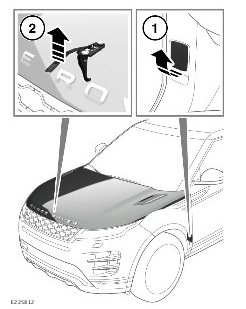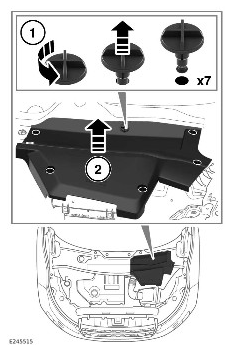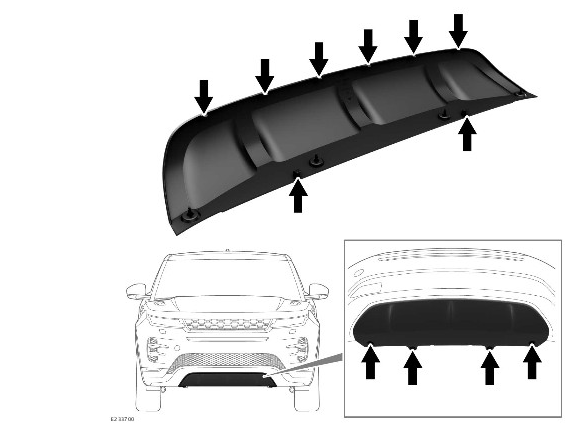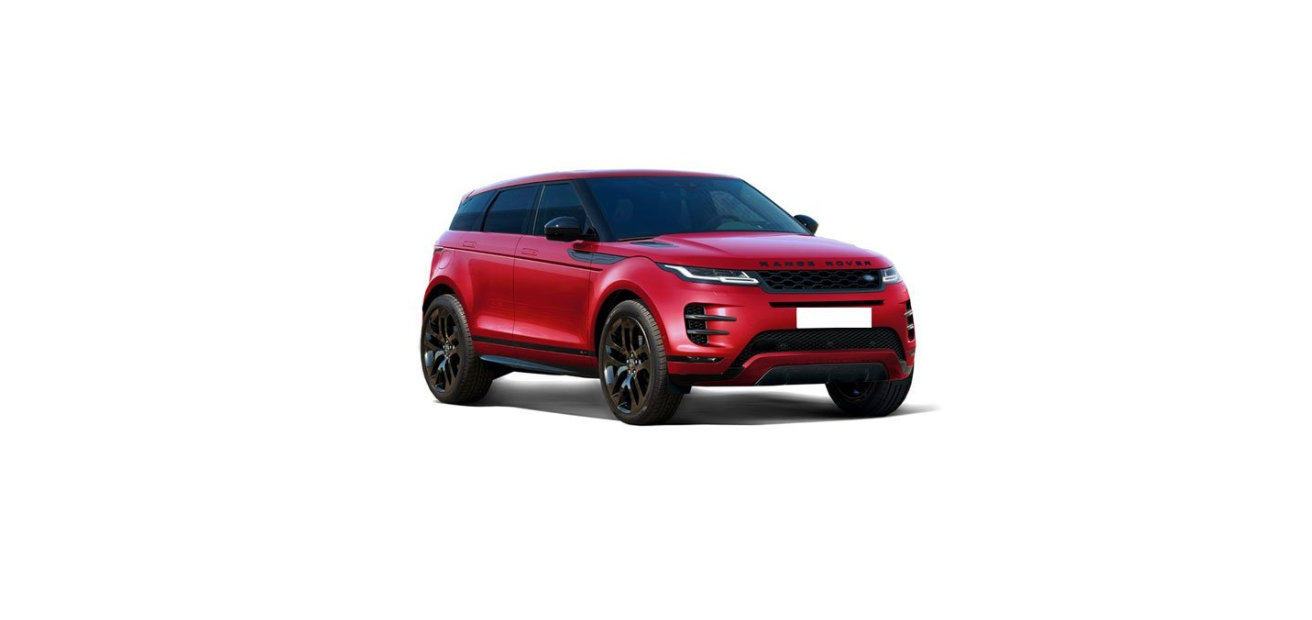2022 Land Rover New Range Rover Evoque Maintenance
BREAKING-IN
The vehicle is built using high-precision manufacturing methods, but the moving parts of the engine must still settle in relative to each other. The breaking-in process occurs mainly in the first 2 000 mi (3 000 km) of operation.
During the breaking-in period of 2 000 mi (3 000 km), observe and follow the instructions below:
- Do not fully press the accelerator pedal.
- Avoid high engine speeds (rpm) until the engine has reached its full operating temperature.
- Avoid operating the engine in too high a gear at low engine speeds (laboring).
- Gradually increase engine and road speeds.
- Avoid extended operation at high engine speeds with abrupt stops.
- Avoid frequent cold starts followed by short-distance driving. Where possible, allow the engine to reach operating temperature.
- Longer journeys are more helpful during the breaking-in period.
- Do not participate in off-road driving, competition driving, track days, sports driving schools, or any similar events.
AIR CONDITIONING (A/C)
With reference to US legislation relating to Air Conditioning (A/C) refrigerants, J2845 Technician Training for Safe Service and Containment of Refrigerants Used in Mobile Air Conditioning (A/C) Systems (HFO-1234yf) states that under no circumstances should any part of the A/C system be serviced, dismantled, or replaced by anyone other than suitably qualified and certified personnel. Make sure that the refrigerant is correctly contained at all times. Failure to adhere to the above may result in serious personal injury or death.
All replacement parts for the Air Conditioning (A/C) system must be new and equivalent to the manufacturer’s original equipment. All replacement parts must comply with the relevant SAE standard (J2842). Contact a retailer/authorized repairer for advice. Failure to do so may lead to serious personal injury or death.
The following symbols may be used on an under-hood label and are relevant to the refrigerant fluid:

A/C symbol.

Lubricant symbol.
Caution.
Flammable refrigerant.
Required registered technician to service A/C system.

Consult the Owner’s Handbook.
OWNER MAINTENANCE
Any significant or sudden drop in fluid levels, or uneven tire wear, should be reported to a qualified technician without delay. Failure to do so may damage the vehicle and lead to accidents, potentially resulting in serious injury or death. In addition to routine maintenance, a number of simple checks must be carried out more frequently. See DAILY CHECKS and WEEKLY CHECKS.
DAILY CHECKS
Check the operation of the following every day:
- Lights.
- Horn.
- Turn signals.
- Windshield wipers.
- Windshield washers.
- Warning lamps.
- Seat belts.
- Brakes.
Look for fluid deposits underneath the vehicle that might indicate a leak.
Condensation drips from the Air Conditioning (A/C) system are normal.
WEEKLY CHECKS
- Engine oil level.
- Engine coolant level.
- Brake fluid level.
- Screen washer fluid level.
- Tire pressures and condition.
- The Air Conditioning (A/C) system.
The engine oil level should be checked more frequently if the vehicle is driven for prolonged periods at high speeds.
ARDUOUS DRIVING CONDITIONS
When a vehicle is operated in extremely arduous conditions, more frequent attention must be paid to servicing requirements.
Arduous driving conditions include:
- Driving in dusty and/or sandy conditions.
- Driving on rough and/or muddy roads.
- Frequent wading.
- Frequent driving at high speeds in high ambient temperatures above 122 °F (50 °C).
- Frequent driving in severe cold weather down to -40 °F (-40 °C).
- Frequent driving in mountainous conditions.
- Frequent trailer towing.
- Driving in areas using road salt or other corrosive materials on the driving surface.
Contact a retailer/authorized repairer for advice.
ANTI-THEFT SYSTEM
No modifications or additions should be made to the anti-theft system. Such changes could cause the system to malfunction, which increases the risk of theft.
AIRBAG SYSTEM
The components that make up the air bag system are sensitive to electrical or physical interference. Electrical and/or physical interference could easily damage the system and cause inadvertent operation or a malfunction of the air bag module. Air bags should only be repaired by an authorized repairer. If the air bags are not repaired correctly, they may not operate correctly during a collision, which may lead to serious injury or death.
To prevent malfunction of the air bag system, always consult a retailer/authorized repairer before fitting any of the following:
- Electronic equipment such as a mobile phone, two-way radio, or in-vehicle entertainment system.
- Accessories attached to the front of the vehicle.
- Any modification to the front of the vehicle.
- Any modification involving the removal or repair of any wiring or component in the vicinity of any of the air bag system components. The components include the steering wheel, steering column, and instrument and dashboard panels.
- Any modification to the dashboard panels or steering wheel.
PARTS AND ACCESSORIES
The fitting of non-approved parts and accessories, or the carrying out of non-approved alterations or conversions, may be dangerous. Doing so could affect the safety of the vehicle and occupants, and also invalidate the terms and conditions of the vehicle’s warranty.
All replacement parts for the Air Conditioning (A/C) system should be new and equivalent to the manufacturer’s original equipment, while complying with the SAE standards. Contact a retailer/authorized repairer for advice. Failure to adhere to the above may lead to serious injury or death.

The extremely flammable symbol may be used on an under-bonnet label. The symbol is relevant to the Air Conditioning (A/C) refrigerant fluid. The symbol identifies flammable chemicals that have low flash and boiling points, and gases that catch fire when exposed to air. Jaguar Land Rover Limited accepts no liability for death, personal injury, or damage to property, occurring as a direct result of non-approved modifications. These modifications include but are not limited to: fitment of non-approved accessories, and the carrying out of non-approved conversions to the vehicle.
SAFETY WHEN CARRYING OUT VEHICLE CHECKS
Make sure the following warnings have been read and fully understood before carrying out vehicle checks. Failure to follow the guidance given could affect vehicle safety, leading to serious injury or death.
Vehicle repairs should only be carried out by a suitably qualified technician. Failure to have repairs carried out by a suitably qualified technician may result in vehicle damage, injury or death.
If the vehicle has been driven recently, do not touch the engine, exhaust, or cooling system components until the engine has cooled. Skin contact with hot parts of the car could result in injury.
Never leave the engine running when the vehicle is in a garage. Exhaust gases are poisonous and can cause unconsciousness and death if inhaled.
Do not work beneath the vehicle with the wheel changing jack as the only means of support. The jack is designed for wheel changing only. Always use correctly-rated vehicle support stands, before putting any part of the body beneath the vehicle. Climbing under a vehicle supported only by a jack may result in injury or death.
Keep hands and clothing away from drive belts, pulleys and fans. Some fans may continue to operate after the engine has stopped. Contact with moving fans could result vehicle damage and injury.
Remove metal wristbands and jewelry before working in the engine compartment. Metallic objects could cause a short circuit, leading to fire, injury or death.
Do not touch electrical leads or components while the engine is running, or with the ignition turned on. High voltage in the ignition system could cause injury or death.
Do not allow tools or metal parts of the vehicle to make contact with the battery leads or terminals. Metallic objects could cause a short circuit, leading to fire, injury or death.
POISONOUS FLUIDS
Fluids used in motor vehicles are poisonous and should not be consumed or brought into contact with open wounds. Vehicle fluids may cause serious injuries or infection, which can result in death. For safety, always read and obey all instructions printed on labels and containers.
USED ENGINE OIL
Prolonged contact with engine oil may cause serious skin disorders, including dermatitis and cancer of the skin. Always wash thoroughly after contact.
Pollution of drains, waterways, or soil is illegal. Use authorized waste disposal sites to dispose of used oil and toxic chemicals.
OPENING THE HOOD
Before opening the hood, make sure that the ignition is switched off and the smart key is removed from the vehicle. Failure to do so can potentially result in serious injury or death.

To open the hood:
- Pull the handle, located in the left-side front footwell, to release the hood securing latch.
- Lift the hood safety catch, located below the center point of the hood. Raise the hood.
CLOSING THE HOOD
Before closing the hood, make sure that no-one is obstructing the closing area and that hands and clothes are clear. The closing hood may cause serious injuries.
Do not drive with the hood secured by the safety catch alone. If the hood opens while driving, it may lead to a collision, which may cause serious injuries or death.
When closing the hood, make sure to stand in front of the vehicle. Do not attempt to close the hood while standing at the side of the vehicle. Doing so may result in incorrect latching of the hood, which may cause serious injuries or death.
To close the hood:
- Using both hands, lower the hood and let it drop from a height of between 8 to 20 in (20 to 50 cm).
- Try to lift the front edge of the hood, near both corners, to check that it is securely engaged.
- If the hood lifts slightly, it is not properly latched. Open the hood again, and with a little more force, try again to close it.
UNDER-HOOD COVERS REMOVAL

- Unscrew the turnbuckles clips counter-clockwise and remove them.
- Lift the front edge of the cover and slide forward to remove it.

- Unscrew the turnbuckle clips counter-clockwise and remove them.
- Lift the cover to remove.
UNDER-HOOD COVERS REFITTING
Before refitting the under-bonnet cover, make sure no pipes, cables, or other items have been trapped between the cover and the casing. Trapped parts may damage vehicle components.
- Place the under-hood cover over the casing. Make sure that all of the holes are aligned.
- Push the cover down firmly and screw the turnbuckle clips clockwise to tighten.
FRONT LOWER BUMPER COVER REMOVAL
Make sure that the cover is correctly fitted before driving the vehicle. An incorrectly fitted cover may become detached from the vehicle and may become damaged.
All vehicles except Dynamic: Remove the lower bumper cover before driving off-road, to prevent damage or loss. If in doubt, contact a retailer/authorized repairer.

To remove the front lower bumper cover:
- Remove the 4 screws.
- Release the 6 upper tabs and the 2 lower tabs.
To install the front lower bumper cover, reverse the removal procedure.
FUEL SYSTEM
Under no circumstances should any part of the fuel system be dismantled or replaced by anyone other than a suitably qualified vehicle technician. If any parts are replaced by an unqualified person, this may cause interference in the operation of the vehicle, leading to serious injury or death.
Make sure sparks and open flames are kept away from the engine compartment. A spark may cause an explosion, which may lead to serious injuries or death.
Wear protective clothing, including, where possible, gloves made from an impervious material. Failure to do so may result in serious injury or death.
If fuel odor is detected, switch off the vehicle and exit as soon as possible. Contact a suitably qualified vehicle technician. Failure to do so could lead to serious injuries or death.
CHANGING A BULB
All lights are LED units and must only be replaced by a retailer/authorized repairer.
EMISSION CONTROL SYSTEM
The vehicle is fitted with various items of emission and evaporative control equipment, designed to meet specific territorial requirements. You should be aware that unauthorized replacement, modification or tampering with this equipment by an owner or repair shop, may be unlawful and subject to legal penalties. In addition, engine settings must not be tampered with. These have been established to make sure the vehicle complies with stringent exhaust emission regulations. Incorrect engine settings may adversely affect exhaust emissions, engine performance, and fuel consumption. They may also cause high temperatures, which will result in damage to the catalytic converter and the vehicle.
Exhaust fumes contain poisonous substances which can cause unconsciousness and may even be fatal.
- Do not inhale exhaust gases.
- Do not start or leave the engine running in an enclosed unventilated area.
- Do not drive the vehicle with the tailgate open.
- Do not modify the exhaust system.
- Exhaust leaks should be repaired immediately.
- If exhaust fumes are thought to be entering the vehicle, have it investigated immediately.
Running out of fuel can result in a misfire. This can cause damage to the emission control system.
WIPERS SERVICE POSITION
To avoid damage to the hood, do not lift the wiper blades when they are in the normal parked position.
The smart key must remain in the vehicle while the wiper blades are being replaced.
Fit only replacement wiper blades that are identical to the original specification.
Replace the wiper blades in accordance with the manufacturer’s instructions.
Before changing a wiper blade, the wiper arms must be set in the service position as follows:
- Make sure the vehicle’s ignition is switched off.
- Switch the vehicle’s ignition on and then off again.
- Immediately press the wash/wipe control to its lowest position, as if to command a single wipe. Hold this position while switching on the vehicle’s ignition again. The wipers move to the service position. See WIPER OPERATION.
- When the new parts have been fitted, switch the vehicle’s ignition off. The wipers return to the park position.
SUNROOF RESET
Before closing the sunroof, make sure that no occupants have any part of their body in a position where it could be trapped. Even with an anti-trap system, death or serious injury could occur. See SUNROOF ANTI-TRAP MECHANISM.
The anti-trap system is disabled during the reset cycle. Make sure that no occupants have any part of their body in a position where it could be trapped, potentially leading to serious personal injury or death.
Make sure that the conditions, listed below, are met before carrying out the sunroof and/or roof blind reset procedure:
- The ambient air temperature is between 41°F (5°C) and 149°F (65°C).
- The vehicle is stationary.
- The vehicle’s battery is sufficiently charged and the electrical connections are good.
The sunroof and/or roof blind need to be reset if the battery is disconnected becomes discharged, or the power supply is interrupted.
Once the power supply is restored, reset the sunroof and/or roof blind as follows:
- Switch the ignition on.
- Manually close the sunroof and/or roof blind. Release the switches. See ELECTRIC WINDOWS.
- Fully press and hold the front of the sunroof switch for 10 seconds to start the reset cycle. Continue to hold the front of the sunroof switch.
NOTES
If the switch is released, the whole procedure has to be repeated.
- The reset cycle:
Fully opens the roof blind.
Fully opens and then fully closes the sunroof.
Fully closes the roof blind.
- Once the reset cycle has completed and the roof blind has stopped moving, release the switch.
The sunroof and/or the roof blind can now be operated as normal.
PANORAMIC ROOF BLIND RESET
The following procedure also resets the panoramic roof.
The roof blind needs to be reset if the battery is disconnected, becomes discharged, or the power supply is interrupted. The reset procedure is as follows:
- Start the engine.
- With the roof and blind closed, press the roof close switch firmly and hold for approximately 10 seconds. The roof/blind will make an audible click.
- Release the switch.
- Within 5 seconds, press and hold the roof close switch again. The roof blind and roof blind opening panel will both fully open, then both close. Release the switch once the movement is complete.
The panoramic roof/blind can now be operated as normal.
WINDOW RESET
The windows need to be reset if the battery is disconnected, becomes discharged, or the power supply is interrupted.
Reset as follows:
- Close the window fully. See ELECTRIC WINDOWS.
- Release the switch. Lift the switch to the close position and hold for 1 second.
- Repeat the procedure on each window.
Make sure that a minimum of 12V is available at all times. It is recommended to have the engine running while resetting the windows.


